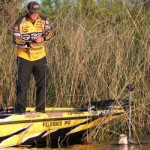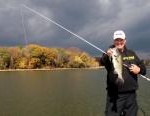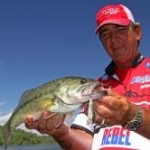How Deep-South Bass Deal With Fall Cold Fronts
(And How To Still Catch Them)
By William Redmond
from The Fishing Wire
Technically, it’s not “cold” just yet, but Mother Nature likes to fiddle with fishermen on the front and backside of winter with minor fronts that rattle the bass fishing cage just enough to push anglers outside their comfort zone. Adjustments may range from minor tweaks to major overhauls, and experienced fishermen keep all options open.
We asked a couple of top-shelf southern bass pros, Terry Scroggins and Zell Rowland, for their insight into making the right moves for fall’s post-front days. Scroggins knows Florida bass fishing as well as anyone in the country, and Zell’s been a South-Texas legend for many years. Each contributes advice on catching cold-front bass in their home states.
FLORIDA FUNK
Elite Pro Terry Scroggins likes flippin’ with a heavy weight in thick cover after the first cold front of fall.Scroggins said specific movements depend on the body of water. In rivers like the St. Johns, he looks for fish to stack around shell bars. You’ll keep the rods bent in this scenario, but he says that it’s definitely quantity over quality.
“A lot of times in the fall they’ll gang up on shell bars,” he said. “Typically, they’re not very big but you can still catch the numbers. That’s typically a fallback pattern that you can go to if you need it.
“Most of that is current-related (activity). The bait gets schooled up and the fish just sit there on ambush points, current breaks and things like that and wait for something to wash over them.”
When post-frontal bass hug tight to the shell bars, it’s hard to beat a Carolina rig. Just consider the scene: A pack of fish are holding on the structure’s down-current side with high hopes of nabbing an easy meal, when all of a sudden this noisy little egg-shaped deal comes clickity-clacking across that mound of bivalves. The intruder doesn’t look edible, but hold on just a second. What’s this tasty little morsel strolling along back there all by its lonesome?
No doubt, waking up the gang with a tungsten weight positioned 3- or 4-feet in front of a Yum Mighty Worm in Junebug or Red Bug is an easy sell. That being said, Scroggins knows that if the bite slows on the shell bar, he often can trigger a few more fish by changing the way he retrieves the rig.
Scroggins also finds fish on offshore shell bars, where a Carolina rig is hard to beat.By switching from the standard Carolina rig lateral sweep to more of a sharp upstroke action, Scroggins maximizes the noise potential of his Carolina rig. The usual retrieve is certainly no stealthy approach – the weight rattles and rumbles in steady cadence — but when the weight jumps several inches off the bottom and belly flops back into the shell bed below, the resulting “crack” is a sure enough attention-getter.
At grassy Florida lakes like Okeechobee, there are more opportunities to target big bass as the season’s initial cold snaps trigger the fish to head for the safety of thick vegetation. The thicker the better, Scroggins said of this straight-up flip-fest.
“Anytime I encounter these conditions — which I like — I find the heaviest, densest cover and start flippin’,” he said. “Most of the time, the fish will be in 3 to 5 feet of water.”
In the weed mats, Scroggins keeps it simple – just a Texas-rigged Yum Wooly Bug, a stout 5/0 flipping hook and enough weight to drive the whole deal through the salad. Typical range is 1 ¼- to 1 ½-ounce, but Scroggins said he rarely pegs his weight when flipping and punching Florida lakes. He says that the thick layer of detritus (decaying organic matter) can stand several inches off the bottom and when a bait makes it through cover without drawing a bite, a pegged rig will take the bait beneath the muck where bass can’t see it. An unpegged weight will continue to the bottom, but the bait will stay on top of the gunk.
LONE STAR LOW DOWN
In weedy Texas Lakes like Sam Rayburn and Toledo Bend, Zell Rowland expects early cold fronts to push bass up from their summer haunts to the shallow hydrilla beds. In Texas lakes featuring little or no grass (example: Conroe), the fronts usher bass up to shallow drops. These post-frontal zones are easy to spot with polarized glasses, as the light sandy bottom distinctly darkens with the falling depth.
Zell Rowland turns on Texas bass after a front with his namesake Zell Pop, among other lures“Anytime that water temp starts to drop 6- to 10-degrees, those bass go crazy,” Rowland said. “It moves them up shallow. It almost gets them into a feeding frenzy like they do in the spring after they spawn.”
In grass-free lakes, Rowland finds that swimming a Texas-rigged Yum Money Minnow along those drop-off edges delivers plenty of action. Around grass, he favors a splashy surface display with his namesake XCalibur Zell Pop, a Rebel Pop-R or even a Zara Spook. If he thinks the fish require a really boisterous display, he’ll pull the old reliable Smithwick Devil’s Horse and get to sputtering.
For optimal grass-friendly presentations, Rowland also keeps a Booyah Pad Crasher frog handy – in walking and popping styles. And when the fish are really being stubborn, he’ll dress up his amphibian with No. 1 willow blades – one on each side of the double hook, attached with a swivel and split ring.
“This gives the bait flash and vibration, while those blades are also hitting each other and creating noise,” Rowland said.
Whatever he throws, Rowland said he reminds himself that these post-frontal fish may still feed, but they’re not nearly as rambunctious as they were before the chill. Therefore, casting accuracy is paramount.
“It’s really critical where you throw the bait – it has to be on the edge (of the grass or a drop-off),” Rowland said. “Your casts have to be pretty precise and then you have to experiment to see what speed they want the bait moving.”


